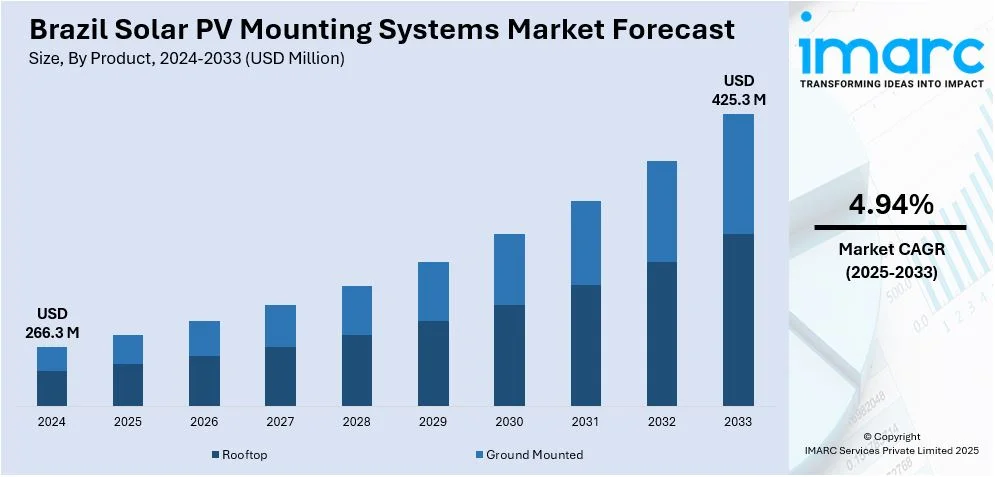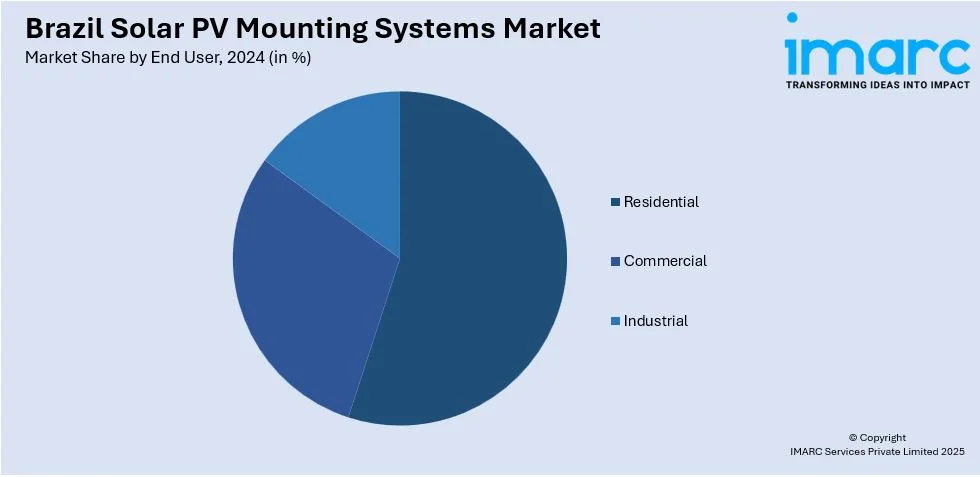
Brazil Solar PV Mounting Systems Market Size, Share, Trends, and Forecast by Product, Technology, Component, End User, and Region, 2025-2033
Brazil Solar PV Mounting Systems Market Overview:
The Brazil solar PV mounting systems market size reached USD 266.3 Million in 2024. Looking forward, IMARC Group expects the market to reach USD 425.3 Million by 2033, exhibiting a growth rate (CAGR) of 4.94% during 2025-2033. Increased solar energy adoption, government incentives, and subsidies, declining costs of solar panels, rising electricity demand, environmental sustainability goals, ongoing technological advancements, and the country's expanding renewable energy infrastructure are some of the key factors impelling the market growth.
|
Report Attribute
|
Key Statistics
|
|---|---|
|
Base Year
|
2024 |
|
Forecast Years
|
2025-2033
|
|
Historical Years
|
2019-2024
|
| Market Size in 2024 | USD 266.3 Million |
| Market Forecast in 2033 | USD 425.3 Million |
| Market Growth Rate 2025-2033 | 4.94% |
Brazil Solar PV Mounting Systems Market Trends:
Growing government support and incentives for solar energy:
In Brazil, numerous government programs and laws were enacted to promote the implementation of renewable energy, especially solar power. The distributed generation program provides numerous advantages to individuals and businesses generating solar power systems. These benefits include energy offsetting mechanisms and net metering under which solar system owners can utilize credits for any extra energy fed into the grid, to defer future electricity bills. For instance, in January 2025, Brazil announced the approval of 543.25 MW of solar projects, including Statkraft's 102 MW and Enel's 50 MW, for the REIDI program, exempting them from PASEP, PIS, and COFINS taxes. Furthermore, the government provides tax breaks and funding choices for solar energy installations, lowering initial costs and promoting wider adoption. This legislative support has created an enabling climate for the expansion of solar PV mounting systems, which are critical to the installation and efficiency of solar panels.

Declining costs of solar technology and equipment:
In Brazil, the cost of solar panels and associated equipment, including mounting systems, has witnessed a vast decline, thus making it very affordable for residential and commercial users. A combination of continuous advancements in manufacturing techniques, optimization of supply chains on a global scale, and economies of scale has contributed to bringing competitive pricing to the front for the production of solar components. For instance, in November 2024, Brazil raised the import tariff on solar modules from 9.6% to 25% to boost domestic manufacturing. Additionally, technological innovations in mounting systems, such as more efficient designs and easier installation methods, have reduced labor costs and installation times. This decline in costs has made solar power an economically viable alternative to traditional energy sources, encouraging more individuals and companies to invest in solar PV systems. As a result, the demand for high-quality and cost-effective mounting systems has increased, driving market growth.
Increasing electricity demand and energy security concerns:
Brazil’s growing population and industrial expansion have led to a surge in electricity demand, putting pressure on the country’s energy grid. At the same time, the country is facing challenges related to energy security, particularly due to its reliance on hydropower, which is vulnerable to fluctuations in water availability caused by climate change. Solar energy has emerged as a reliable and sustainable alternative, offering a solution to diversify the energy mix and reduce dependency on hydropower. For instance, in November 2024, Brazil reached 3 million solar systems installed, leading globally in photovoltaic adoption. In 2024, 650,000 systems were added, contributing 7.1 GW to the national electricity grid. The rise in large-scale solar farm projects, as well as distributed solar generation for residential and commercial users, is driving the need for robust and scalable solar PV mounting systems that can support the growing number of solar installations across the country. This trend is propelling the expansion of the Brazil solar PV mounting systems market.
Brazil Solar PV Mounting Systems Market Segmentation:
IMARC Group provides an analysis of the key trends in each segment of the market, along with forecasts at the region/country level for 2025-2033. Our report has categorized the market based on product, technology, component, and end user.
Product Insights:
- Rooftop
- Ground Mounted
The report has provided a detailed breakup and analysis of the market based on the product. This includes rooftop and ground mounted
Technology Insights:
- Fixed
- Tracking
A detailed breakup and analysis of the market based on the technology have also been provided in the report. This includes fixed and tracking.
Component Insights:
- PV Modules (Panels)
- Inverters
- Racking
- Battery
- Others
A detailed breakup and analysis of the market based on the component have also been provided in the report. This includes PV modules (panels), inverters, racking, battery, and others.
End User Insights:

- Residential
- Commercial
- Industrial
A detailed breakup and analysis of the market based on the end user have also been provided in the report. This includes residential, commercial, and industrial.
Regional Insights:
- Southeast
- South
- Northeast
- North
- Central West
The report has also provided a comprehensive analysis of all the major regional markets, which include Southeast, South, Northeast, North, and Central West.
Competitive Landscape:
The market research report has also provided a comprehensive analysis of the competitive landscape. Competitive analysis such as market structure, key player positioning, top winning strategies, competitive dashboard, and company evaluation quadrant has been covered in the report. Also, detailed profiles of all major companies have been provided.
Brazil Solar PV Mounting Systems Market News:
- In August 2024, French renewable energy company GreenYellow revealed its plans to install a 3.96-MWp self-consumption solar rooftop system at an industrial client's factory in Campinas, Sao Paulo. This PV farm is scheduled to be up and running before the end of the year.
Brazil Solar PV Mounting Systems Market Report Coverage:
| Report Features | Details |
|---|---|
| Base Year of the Analysis | 2024 |
| Historical Period | 2019-2024 |
| Forecast Period | 2025-2033 |
| Units | Million USD |
| Scope of the Report | Exploration of Historical Trends and Market Outlook, Industry Catalysts and Challenges, Segment-Wise Historical and Future Market Assessment:
|
| Products Covered | Rooftop, Ground Mounted |
| Technologies Covered | Fixed, Tracking |
| Components Covered | PV Modules (Panels), Inverters, Racking, Battery, Others |
| End Users Covered | Residential, Commercial, Industrial |
| Regions Covered | Southeast, South, Northeast, North, Central West |
| Customization Scope | 10% Free Customization |
| Post-Sale Analyst Support | 10-12 Weeks |
| Delivery Format | PDF and Excel through Email (We can also provide the editable version of the report in PPT/Word format on special request) |
Key Questions Answered in This Report:
- How has the Brazil solar PV mounting systems market performed so far and how will it perform in the coming years?
- What is the breakup of the Brazil solar PV mounting systems market on the basis of product?
- What is the breakup of the Brazil solar PV mounting systems market on the basis of technology?
- What is the breakup of the Brazil solar PV mounting systems market on the basis of component?
- What is the breakup of the Brazil solar PV mounting systems market on the basis of end user?
- What is the breakup of the Brazil solar PV mounting systems market on the basis of region?
- What are the various stages in the value chain of the Brazil solar PV mounting systems market?
- What are the key driving factors and challenges in the Brazil solar PV mounting systems?
- What is the structure of the Brazil solar PV mounting systems market and who are the key players?
- What is the degree of competition in the Brazil solar PV mounting systems market?
Key Benefits for Stakeholders:
- IMARC’s industry report offers a comprehensive quantitative analysis of various market segments, historical and current market trends, market forecasts, and dynamics of the Brazil solar PV mounting systems market from 2019-2033.
- The research report provides the latest information on the market drivers, challenges, and opportunities in the Brazil solar PV mounting systems market.
- Porter's five forces analysis assist stakeholders in assessing the impact of new entrants, competitive rivalry, supplier power, buyer power, and the threat of substitution. It helps stakeholders to analyze the level of competition within the Brazil solar PV mounting systems industry and its attractiveness.
- Competitive landscape allows stakeholders to understand their competitive environment and provides an insight into the current positions of key players in the market.
Need more help?
- Speak to our experienced analysts for insights on the current market scenarios.
- Include additional segments and countries to customize the report as per your requirement.
- Gain an unparalleled competitive advantage in your domain by understanding how to utilize the report and positively impacting your operations and revenue.
- For further assistance, please connect with our analysts.
 Inquire Before Buying
Inquire Before Buying
 Speak to an Analyst
Speak to an Analyst
 Request Brochure
Request Brochure
 Request Customization
Request Customization




.webp)




.webp)












